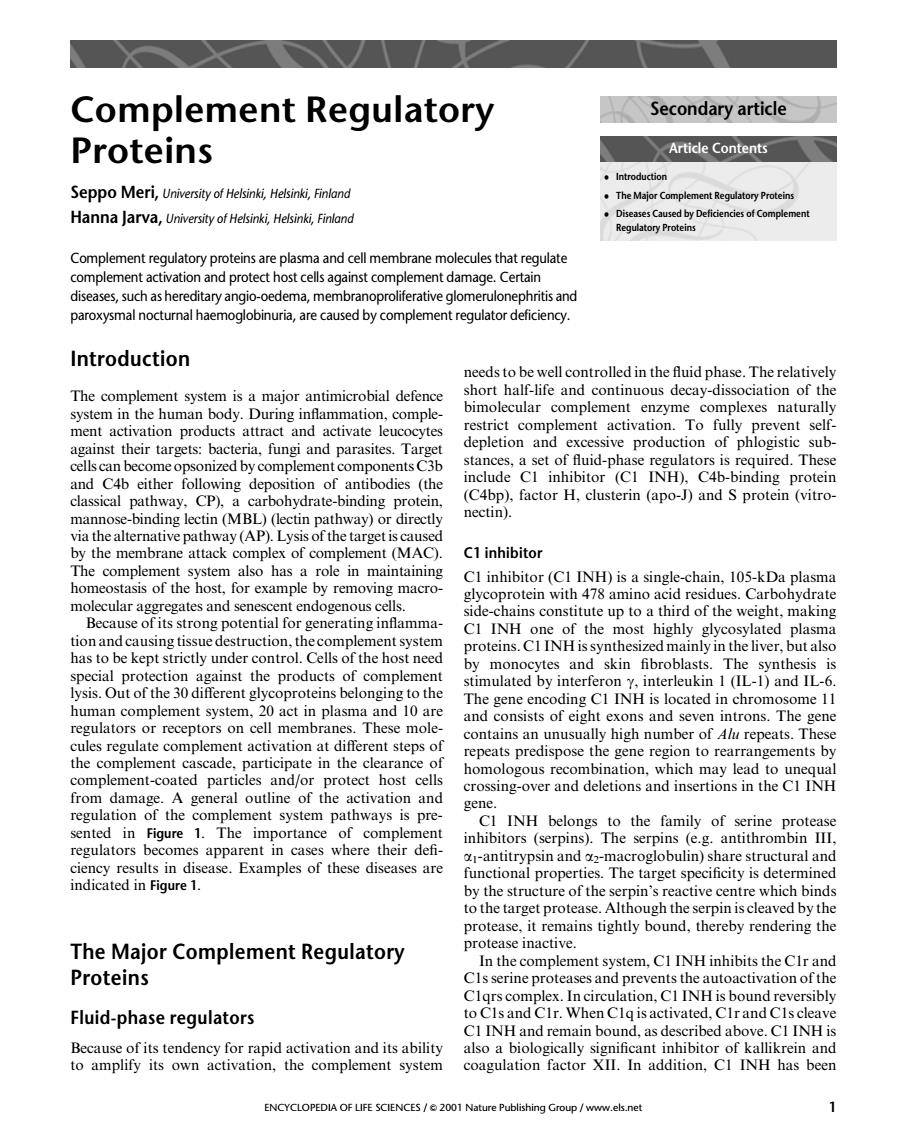正在加载图片...

Complement Regulatory Secondary article Proteins Article Contents uction Seppo Meri,University of Helsinki,Helsinki,Finland t Requlatory Proteins Complemer molecules that regulate sUhashereghndpo na m ohritis and Introduction needs to be well controlled in the fluid phase.The relatively The comp defence short half-life and continuous decay-dissociation of the bimolecular activa ducts and activate tivation.To fully prevent s against their targets:bacteria,fungi and parasites.Targe . tances cells can beco me opsonized by complement compon nts C3b a set of fuid-phase rulators is required.Thes &edrnoanchnibodehe include CI inhibitor(CI INH),C4b-binding protein (C4bp),factor H,clusterin (apo-J)and S protein (vitro- lectin (MBL)(lect nectin) via thealternative pathway (AP).Lysis of the target is cau by the membrane attack complex of complemen (MAC) C1 inhibitor he Cl inhibitor (CI INH)is a single-chain.105-kDa plasma molecular a gates and ser endogenous cells glycoprotein with 478 amino acid residues.Carbohydrate Because of its strong potential for generating inflamma- I of the weig making mos y mo ysis Out of the 30 difterent l g to the mmerone' human complement system,20 act in plasma and 10 are The gene encoding CI INH is located in chromosome 11 ts of eight regulators or receptors on cell membranes These mole seven introns.The cules regulate mplement acti tion the complement-coated particles andor protect host cell homologous recombination,which may lead to unequal from damage.A general outline of the activation and crossing-over and deletions and insertions in the CI INH regulation of the pemmtepahagasp to the family of serine ortance roweac ey results in dise unc indicated in figure 1 h protease.it remains tightly bound.thereby rendering the The Major Complement Regulatory protease inactive. In the complement system,CI INH inhibits the e Cl and Proteins es an Fluid-phase regulators to CIs and CIr.When Clqis activated.Clrand Clscleave CI INH and remain bound,as described above.C1 INH is complement systen ENCYCLOPEDIA OF LIFE SCIENCES/2001 Nature Publishing Group /www.els.net Complement Regulatory Proteins Seppo Meri, University of Helsinki, Helsinki, Finland Hanna Jarva, University of Helsinki, Helsinki, Finland Complement regulatory proteins are plasma and cell membrane molecules that regulate complement activation and protect host cells against complement damage. Certain diseases, such as hereditary angio-oedema, membranoproliferative glomerulonephritis and paroxysmal nocturnal haemoglobinuria, are caused by complement regulator deficiency. Introduction The complement system is a major antimicrobial defence system in the human body. During inflammation, complement activation products attract and activate leucocytes against their targets: bacteria, fungi and parasites. Target cells can become opsonized by complement components C3b and C4b either following deposition of antibodies (the classical pathway, CP), a carbohydrate-binding protein, mannose-binding lectin (MBL) (lectin pathway) or directly via the alternative pathway (AP). Lysis of the target is caused by the membrane attack complex of complement (MAC). The complement system also has a role in maintaining homeostasis of the host, for example by removing macromolecular aggregates and senescent endogenous cells. Because of its strong potential for generating inflammation and causing tissue destruction, the complement system has to be kept strictly under control. Cells of the host need special protection against the products of complement lysis. Out of the 30 different glycoproteins belonging to the human complement system, 20 act in plasma and 10 are regulators or receptors on cell membranes. These molecules regulate complement activation at different steps of the complement cascade, participate in the clearance of complement-coated particles and/or protect host cells from damage. A general outline of the activation and regulation of the complement system pathways is presented in Figure 1. The importance of complement regulators becomes apparent in cases where their defi- ciency results in disease. Examples of these diseases are indicated in Figure 1. The Major Complement Regulatory Proteins Fluid-phase regulators Because of its tendency for rapid activation and its ability to amplify its own activation, the complement system needs to be well controlled in the fluid phase. The relatively short half-life and continuous decay-dissociation of the bimolecular complement enzyme complexes naturally restrict complement activation. To fully prevent selfdepletion and excessive production of phlogistic substances, a set of fluid-phase regulators is required. These include C1 inhibitor (C1 INH), C4b-binding protein (C4bp), factor H, clusterin (apo-J) and S protein (vitronectin). C1 inhibitor C1 inhibitor (C1 INH) is a single-chain, 105-kDa plasma glycoprotein with 478 amino acid residues. Carbohydrate side-chains constitute up to a third of the weight, making C1 INH one of the most highly glycosylated plasma proteins. C1 INH is synthesized mainly in the liver, but also by monocytes and skin fibroblasts. The synthesis is stimulated by interferon g, interleukin 1 (IL-1) and IL-6. The gene encoding C1 INH is located in chromosome 11 and consists of eight exons and seven introns. The gene contains an unusually high number of Alu repeats. These repeats predispose the gene region to rearrangements by homologous recombination, which may lead to unequal crossing-over and deletions and insertions in the C1 INH gene. C1 INH belongs to the family of serine protease inhibitors (serpins). The serpins (e.g. antithrombin III, a1-antitrypsin and a2-macroglobulin) share structural and functional properties. The target specificity is determined by the structure of the serpin’s reactive centre which binds to the target protease. Although the serpin is cleaved by the protease, it remains tightly bound, thereby rendering the protease inactive. In the complement system, C1 INH inhibits the C1r and C1s serine proteases and prevents the autoactivation of the C1qrs complex. In circulation, C1 INH is bound reversibly to C1s and C1r. When C1q is activated, C1r and C1s cleave C1 INH and remain bound, as described above. C1 INH is also a biologically significant inhibitor of kallikrein and coagulation factor XII. In addition, C1 INH has been Article Contents Secondary article . Introduction . The Major Complement Regulatory Proteins . Diseases Caused by Deficiencies of Complement Regulatory Proteins ENCYCLOPEDIA OF LIFE SCIENCES / & 2001 Nature Publishing Group / www.els.net 1